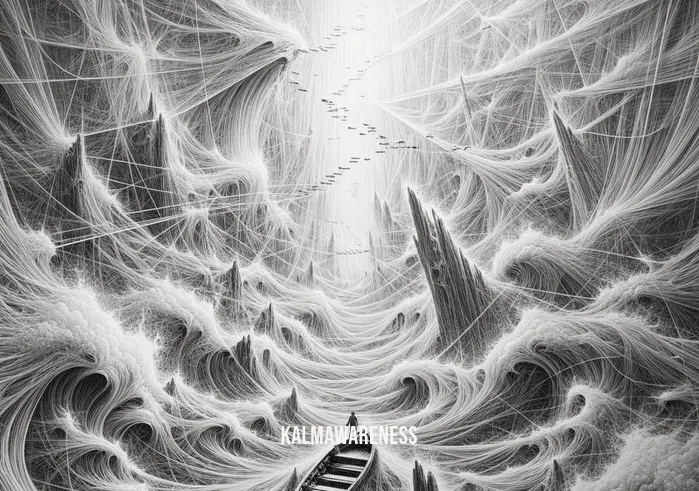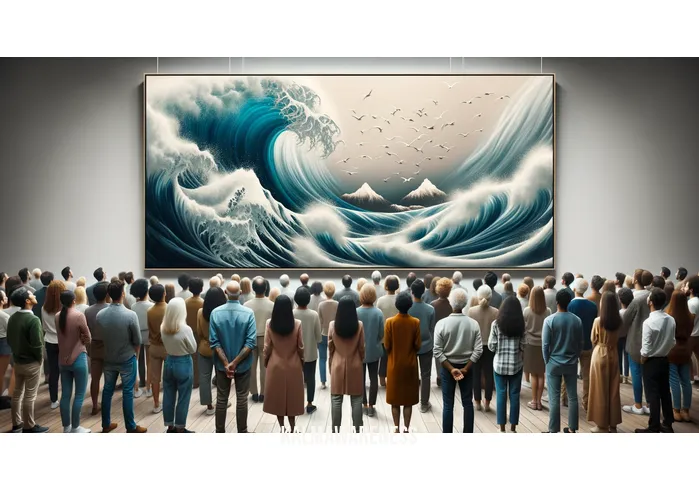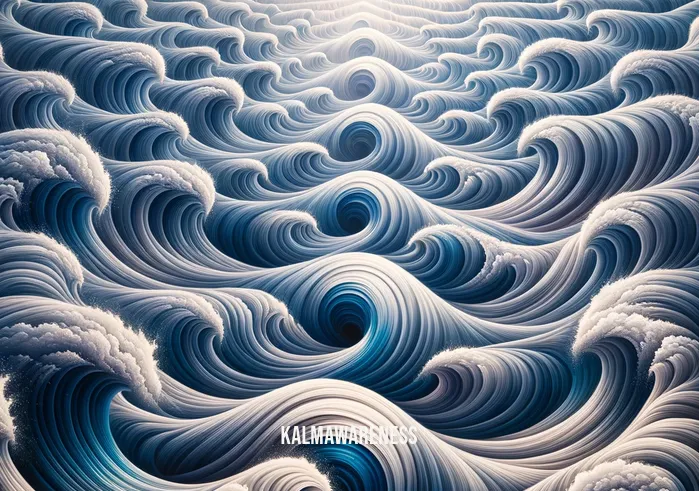An Invitation to Simple Waves Drawing: The Confluence of Serenity, Creativity, and Inspiration
In a world brimming with constant commotion, the serenity found in nature’s simplest patterns offers a much-needed respite. The gentle undulation of waves, their rhythmic dance, encapsulates notions of flow, harmony, and tranquility. This article seeks to bridge your yearning for peace with an act of creation—embarking on a journey of simple waves drawing. By uniting the principles of Serene, Flow, Motion, Harmony, and Tranquility, you’ll discover a newfound source of inspiration and creativity.
Why Waves Speak to Our Souls
Our connection to waves is more profound than mere admiration. It is no surprise that calming ocean pictures are amongst the most sought-after visual aids for relaxation. The sound, the visual, and the energy they carry resonate with our innermost sentiments. Waves embody motion and yet, they are the epitome of calm. Like the eye of the hurricane meditation, where tranquility exists amidst chaos, waves convey a similar duality. Their ceaseless movement invokes a sense of continuity, reminding us that change is the only constant.
The Artistic Journey of Drawing Waves
But why translate this admiration into art? Drawing, like comfort meditation, allows one to tap into areas of the psyche previously unexplored. As you draw these waves, you are not just mimicking their appearance but are in essence, capturing their spirit. The simple act of replicating their patterns on paper lets you tap into creativity, bringing forth emotions, memories, and thoughts that have been lying dormant.
The process:
- Begin with observation. Notice the waves in calm ocean pictures, focusing on their structure and rhythm.
- Embrace the mindful balance as you sketch. Let your hand flow in harmony with your observations, losing yourself in the act.
- As you progress, you’ll realize the gentle are movements of your hand, the interplay of your tools, and the paper merge in a dance similar to the waves themselves.
Why Waves are More than Just Curves on Paper
Drawing waves is not a mere replication of what the eyes see. It is an internal process. A focused relaxation technique. As you draw each curve, you are, in essence, meditating. The drawing becomes your cloud meditation, where every stroke takes you a step closer to your inner self, helping you attain peace akin to global peace meditation.
The Therapeutic Benefits of Simple Waves Drawing
“In drawing, one must look for or suspect that there is more than is casually seen.” – George Bridgman.
When we engage in the act of drawing waves, we aren’t just creating art; we’re indulging in therapy. This practice offers:
- Emotional Balance: Like the teachings of cultivating emotional balance, drawing waves allows one to confront emotions, process them, and attain equilibrium.
- Stress Relief: Immersing in the process diverts the mind from daily concerns, offering a backdrop akin to stress relief backgrounds.
- Enhanced Creativity: The repeated practice can open portals of creativity, not very different from understanding the power of closing spiritual portals to let go of limiting beliefs.
This exploration is only the beginning. The connection between our souls, the allure of waves, and the creative power of drawing them offers profound insights. Through this journey, not only will you grasp the techniques and intricacies of creating beautiful wave illustrations but will also understand the deeper significance they carry.
As you advance in this path, be ready to delve deeper into the realms of art, mindfulness, and introspection in the next segment. A world where drawing is not just an act but a meditative experience awaits. Delve deeper into the harmony of waves, drawing inspiration from beach guided imagery and expanding your horizons of creativity.
Continue reading as we unearth the step-by-step process, delve into the intricacies of wave patterns, and their power to inspire and soothe the soul.

Crafting the Rhythmic Dance: A Detailed Guide to Simple Waves Drawing
Simple wave drawings can captivate viewers with their minimalistic beauty and rhythmic patterns. At first glance, they might seem effortless. Yet, mastering the intricacies of this art form requires a blend of observation, technique, and passion. As we delve deeper into this realm, we’ll explore the nuances of creating mesmerizing wave illustrations and the tools that can assist you in this artistic pursuit.
Essential Tools for Simple Waves Drawing
Before setting sail on this voyage, ensuring you have the right toolkit is crucial. Here’s a curated list to enhance your drawing experience:
- Pencils: The backbone of every artist. Opt for a range of softness to capture the varied intensity of waves.
- Ink Pens: For the final outlines, ensuring crispness in your drawing.
- Eraser: To rectify mistakes and fine-tune details.
- Paper: Thick, smooth paper, preferably in the A4 or A3 size, allows for a detailed portrayal.
- Colored Pencils or Watercolors: If you wish to add hues to your waves, capturing the depth and moods of the ocean.
To optimize these tools, refer to the table below that offers a concise breakdown:
| Tool | Purpose | Tips for Usage |
|---|---|---|
| Pencil | Sketching initial outlines | Start light, gradually intensify |
| Ink Pen | Finalizing drawing | Steady hand, consistent pressure |
| Eraser | Correcting errors | Gentle strokes to avoid paper damage |
| Paper | Canvas for drawing | Avoid extreme textures; it might distort the wave patterns |
| Colors | Enhancing visual appeal | Light shades for shallow waters, darker hues for depth |
The Anatomy of a Wave
Understanding waves’ structure is essential. Every wave showcases:
- Crest: The wave’s highest point.
- Trough: The lowest point, nestled between crests.
- Amplitude: The height from the rest position to the crest or trough.
- Wavelength: The distance between two consecutive crests or troughs.
When creating a mindful balance in your drawings, this knowledge will guide your hand, ensuring accuracy and depth.
Progressing from Observation to Illustration
One must not overlook the importance of observing before drawing. It’s like a guided sleep meditation with music; the observation phase sets the tone, and the drawing completes the symphony.
- Observation: Spend time observing calm dragon or waves on a serene beach. Notice the rhythm, the play of light, and the interaction with the shore.
- Initial Sketch: Using a pencil, sketch the wave’s basic structure. Capture the crest, trough, and the overall flow.
- Detailing: Introduce textures and patterns. The gentle foam, the ripples, and the play of light on water.
- Final Outline: With an ink pen, trace the final drawing, ensuring clarity.
- Coloring (Optional): Breathe life into your drawing. Reflect the mood – is it a sunny day with peace in the family? Or a reflective evening with undertones of the beyond light show and meditation?
Benefits and Beyond
Drawing waves is not just an artistic endeavor; it’s therapeutic. As you draw, you engage in cultivating emotional balance, achieving a state similar to focused relaxation. Moreover, your creations can be a centerpiece in spaces that promote calm, complementing stress relief backgrounds or serving as personal reminders of tranquility.
As we’ve journeyed deeper into the art of simple waves drawing, it’s evident that this practice is an amalgamation of observation, skill, and emotion. But our exploration doesn’t end here. In the next chapter, we will immerse ourselves even further, understanding the spiritual connect waves have and the profound impact they can have on our psyche and well-being.
Continue reading to unlock the ethereal dimensions of waves and the serene spaces they can transport us to.

Waves as a Muse: Drawing Hope and Inspiration from Simple Lines
The rhythmic ebb and flow of waves have often served as metaphors for life’s highs and lows. Drawing waves, especially in their simplest forms, isn’t merely a recreational endeavor; it’s a journey into realms of introspection and inspiration. For many, these gentle curves on paper encapsulate profound lessons and hope.
The Philosophical Waves
“In one drop of water are found all the secrets of all the oceans.” – Kahlil Gibran
This quote from the famed Lebanese poet resonates deeply with the act of simple waves drawing. Each curve, every trough, and crest has a story, a myriad of emotions—just as every drop contributes to the vastness of oceans.
At the heart of wave drawing is the reflection of life’s oscillations. When artists bring waves to life on paper, they’re not just illustrating water but emphasizing the calming ocean pictures that life often presents us with, reminding us to find solace in the predictable unpredictability of nature.
Real-life Inspirations
Maya’s Story: Maya, a therapist by profession, found herself amidst a personal crisis. In her attempt to find a meditative outlet, she stumbled upon the art of drawing waves. The rhythmic process, akin to the practices of comfort meditation, became her escape. As she sketched, each wave became symbolic of her challenges and her resilience. Today, her illustrations adorn the walls of her therapy center, serving as a beacon of hope for many.
Liam’s Wave: A software engineer by day, Liam always felt the urban chaos stifling his creativity. One summer, during a trip to the coastline, he sat sketching the waves. The experience, he recounts, was like a cloud meditation – liberating and grounding. He now conducts weekend workshops, marrying technology with the art of wave drawing, guiding others to find a harmonious balance between the digital and natural world.
Quotes that Echo with Waves
“You can’t stop the waves, but you can learn to surf.” – Jon Kabat-Zinn
A potent reminder that challenges are inevitable. However, with the right mindset and skills, like those employed in closing spiritual portals, one can navigate through them.
“The wave does not need to die to become water. She is already water.” – Thich Nhat Hanh
This profound insight underscores that every phase, be it a crest or trough, is transient. Yet, the essence remains unaltered, much like the teachings of Angel Anael, emphasizing love and beauty in every form.
“Life is a series of waves to be embraced and overcome.” – Danny Meyer
Drawing parallels to the eye of the hurricane meditation, this quote emphasizes the calm amidst chaos, the silver lining during adversities, and the hope that simple wave drawings can evoke.
Drawing as a Channel for Hope
There’s a serene power in the process of drawing, especially waves. The act of translating nature’s cadence onto paper is therapeutic. For many, it’s akin to connecting with the ethereal, drawing parallels with gentle are movements, where every stroke becomes a dance of hope, resilience, and tranquility.
The stories and quotes underscore the depth that a simple act of drawing can encompass. As we continue our exploration, the next chapter will delve into the technical intricacies, offering tips and techniques to master the art of simple waves drawing. For those eager to hone their skills and bring more depth to their illustrations, continue reading to uncover the artist’s secrets.

The Artistry Behind Simple Waves: Techniques and Tips
Drawing waves is more than mere illustration—it’s an amalgamation of technique, perception, and emotion. While waves, in essence, represent fluidity, bringing them to life on paper requires a structured approach. Let’s dive deep into the world of simple waves drawing, understanding its intricate details and mastering the craft.
Essential Tools for Drawing Waves
To get started with drawing, one requires tools. While seasoned artists might swear by beyond light show and meditation to illuminate their canvas, beginners can initiate their journey with these fundamental tools:
- Pencil Grades: From the soft 2B to the hard 4H, every pencil has its role.
- Eraser: A kneaded eraser helps with precision.
- Blending Tools: These could be stumps, tissues, or even one’s fingers.
- Paper: Preferably a thick paper to withstand repeated erasures and blending.
Steps to Drawing a Basic Wave
Drawing a wave might seem daunting, but breaking it down step-by-step simplifies the process. Here’s a guide:
- Initial Outline: Start with a gentle curve for the wave crest, using it as a mindful balance between the wave’s body and its pinnacle.
- Adding Details: Sketch the trough of the wave, ensuring the distance is proportionate to the crest.
- Shading: Utilizing the softer pencils, shade the underside of the wave, mirroring the effects of calm counts to create a sense of depth.
- Highlighting: Waves reflect light. Use an eraser to gently lift off some of the pencil work, creating highlights.
- Finishing Touches: Add small ripples around the wave and blend your shading to bring a realistic touch.
Advanced Techniques: Adding Realism
After mastering the basics, it’s time to delve deeper:
Reflection and Refraction: Understand how light interacts with water. Adding light spots and shading the water’s depth can make your drawing resonate with the peaceful imagery found in beach guided imagery.
Foam and Froth: The wave’s pinnacle, where it crashes, creates froth. Gentle dabs with an eraser or light pencil strokes can mimic this effect.
Shadows: Just like in life where shadows play a vital role in cultivating emotional balance, in drawing, shadows add depth and dimension.
Common Mistakes to Avoid
Every artist evolves through trial and error. However, being mindful of common pitfalls can save time:
Overblending: While blending provides smoothness, overdoing it can make the waves appear flat, losing the focused relaxation depth that waves naturally possess.
Ignoring Light Source: Just as global peace meditation emphasizes universal harmony, in drawing, it’s crucial to consider the light source for consistent shading.
Uniform Waves: Nature is diverse. Waves aren’t consistently uniform. Adding variations in size and shape makes your drawing more authentic.
Keep Practicing
“The sea does not reward those who are too anxious, too greedy, or too impatient. One should lie empty, open, choiceless as a beach—waiting for a gift from the sea.” – Anne Morrow Lindbergh
Drawing is akin to meditation. It’s a journey of patience, persistence, and continuous learning. With every stroke, every wave, you don’t just depict water; you capture its essence, its stories, and its myriad lessons.
As our exploration of simple waves drawing nears its culmination, the next chapter promises to encapsulate all that we’ve learned. We’ll focus on how to bring emotions, stories, and philosophies onto the canvas, ensuring your drawings aren’t just illustrations but reflections of life. Continue reading to embark on this final voyage.

Riding the Wave: Reflecting on Simple Waves Drawing
Drawing has always been more than an expression—it’s a journey, a reflection of the soul, and an exploration of the world around us. This dive into the captivating realm of simple waves drawing has been nothing short of enlightening. Waves, with their rhythmic ebb and flow, mirror life’s highs and lows, teaching us lessons in resilience, harmony, and beauty.
The Journey So Far
From the essential tools and techniques to the intricate nuances that add life to a drawing, we’ve traversed a vast ocean of knowledge. Drawing waves, much like the eye of the hurricane meditation, has taught us the importance of calm amidst chaos, the beauty of serenity in motion, and the art of observing nature in its purest form.
Embracing the Essence of Waves
As we draw waves, we’re not merely recreating a visual representation of the sea but capturing its essence. The undulating motion, the serenity of the cloud meditation, the myriad shades of blue, and the shimmer of light dancing on its crest—all these elements come together to tell a story.
Looking Ahead
While our journey in understanding the craft behind simple waves drawing comes to a close, the exploration doesn’t end here. Much like the calm dragon that embarks on new adventures, artists too must venture into new territories, seeking inspiration, learning new techniques, and honing their skills.
Your Next Steps
There’s a wealth of knowledge out there, waiting to be discovered:
Revisit and Revise: Go back to the earlier chapters. Sometimes, revisiting lessons with fresh eyes offers new insights.
Expand Horizons: While waves are fascinating, explore other elements of nature—be it the serenity encapsulated in calming ocean pictures or the raw power depicted in thunderstorms.
Join Our Community: Engage with fellow artists, share your creations, learn from their experiences, and grow together.
A Parting Note
To every reader who embarked on this journey with us, a heartfelt thank you. Your quest for knowledge, your passion for art, and your dedication to mastering the craft of simple waves drawing is truly commendable. As you sketch, paint, or doodle, remember the essence of angel anael: bringing love, light, and hope to the canvas of life.
The ocean of creativity is vast and unending. As you set sail on your artistic endeavors, may your ship be steered by inspiration, your path illuminated by passion, and your journey marked by continuous learning. Stay curious, stay inspired, and most importantly, keep drawing.
Until our next adventure,
The Kalm Awareness Team
P.S. Dive deeper into the world of tranquility and creativity with our vast array of resources. Whether you’re seeking peace in the family or yearning for stress relief backgrounds, our platform has something for every seeker. Explore, learn, and grow with us.




